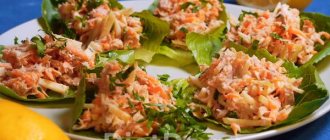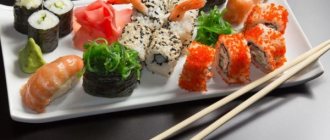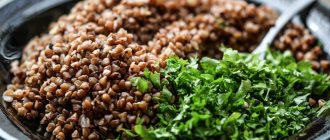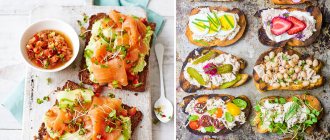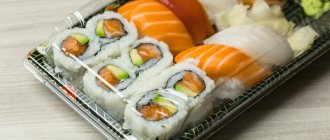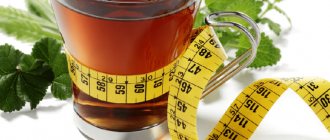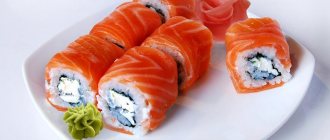7
Prepared by: Alexey Marchuk
11/17/2015 Cooking time: 25 min
| Save | I cooked) | Estimate |
A dietary option for making sushi, without rice. Instead, I add low-fat cottage cheese. The result is a low-calorie dish, which is just right for those who are on a diet. Let's try!
Diet rolls
From the usual ingredients of this Japanese dish, you can prepare diet rolls that are suitable for a wide variety of diets, even strict ones. The main thing is to remember a few simple tips to reduce the calorie content of a dish, but maintain its beneficial properties:
- Regular white rice contains a lot of starch, which inhibits weight loss, so before boiling it must be washed several times or replaced with brown rice, which has a lower glycemic index.
- Avocado, soft cheeses, and mayonnaise are high in calories, so you should avoid such components of the dish.
- The smoked and salty ingredients of the filling retain fluid in the body and prevent weight loss.
- It is better to replace fatty fish (eel, herring) with fish with low fat content (tuna, pink salmon).
- For seafood, you should prefer shrimp or crab meat.
- Soy sauce, ginger, and wasabi should be limited. The first one contains a lot of excess salt, and hot seasonings whet the appetite. As a spicy dressing for the dish, you can prepare a sauce based on lemon juice with the addition of soy sauce and green mustard.
Advantages and disadvantages
| Advantages | Flaws |
|
|
How to make rolls at home
How to choose the right ingredients for making rolls, how to cook rice, how to roll and cut “rolls” correctly, and what else to pay attention to.
In Japan, even a teenager can prepare delicious rolls in just a few minutes - makizushi, or rice “rolls” with filling, wrapped in a sheet of nori seaweed. Let's try to do the same and make rolls at home.
In Japan, the art of making rolls takes a long time to learn. It is important not only to correctly form a rice ball or cut fish, but also to take into account the specifics of choosing products. Rice vinegar (su) It is best if Japanese rice vinegar is used to prepare the rolls. It is different from the sour and hot vinegar that Europeans are accustomed to. Japanese sous is sweetish and not spicy. Important! Low-quality or counterfeit vinegar can ruin rolls made even from the best fish and properly cooked rice.
Wasabi There are two types of wasabi eaten in Japan - seyo and sawa. The latter is expensive and rarely found outside of Japan. Wasabi seyo is sold in almost all stores. Important! If possible, choose powdered wasabi and don't worry about not being able to cook it. Just mix this wasabi with water, and in 5-10 minutes it will be ready for use. Wasabi paste often contains additional “chemicals” for better preservation.
Nori Japanese seaweed can be sold as whole sheets or cut into thin strips. To prepare the rolls you will need nori approximately 18-20 centimeters in size. Important! The darker the nori, the more pronounced its flavor.
Gari (ginger) Simply put, it is pickled ginger. Of course, you can do without it when it comes to making rolls, but you will definitely appreciate its properties when you try makizushi with different fillings. Ginger will help refresh your mouth and neutralize the taste of the previous dish. This means that true gourmets will be able to enjoy every bite. Important! White ginger has a mild flavor, while pink ginger tends to be spicier.
Soy sauce To make the rolls juicier and softer, eat them by dipping them in soy sauce. It tastes less and more salty. Always pay attention to the label and ingredients of the sauce. High-quality sauce is produced without flavorings or dyes. The most important condition for the sauce is that it is made using natural fermentation. Important! You should only buy soy sauce in glass bottles. The aroma, taste and beneficial properties of the product are preserved only in glass and not in plastic packaging.
Other Ingredients It's good if you can buy masago - flying fish roe, which is used optionally for decoration or during the preparation of ura-maki (rolls in which rice is on the outside). It’s not necessary, but you can still use salmon caviar and Japanese mayonnaise with a softer and sweeter taste than the European counterpart we know to make rolls. Also, depending on the recipe and your own imagination, you can use cucumbers, crab sticks, cheese, and avocado.
So, to prepare rolls at home we will need:
Preparing rolls according to Japanese recipes The basis of traditional rolls is rice and fish. If everything is more or less clear with fish (you can buy tuna fillets, salmon, etc.), then preparing the “correct” rice raises many questions. Did you know that in Japanese restaurants only men prepare rolls? It is believed that due to warmer female hands, the taste of the product is distorted. A trifle, you say? But this is the Japanese essence - these people strive for the ideal always and everywhere. It is not surprising that even the banal cooking of rice for rolls is a whole science. But even a European can master it, following some rules.
Cooking rice Choose rice with short and round grains. Long rice will not work because it is very dry and retains water - making a “bun” for nigiri-zushi or wrapping such rice in nori will not work. Wash the rice - this is important. Fill the container with rice with water and, using massaging movements, clean the rice from small debris and husks. The water will take on a milky hue. Don't be lazy. If you don't rinse the rice, it will become covered in sticky starch when cooked. Drain almost all the water and squeeze the rice fairly firmly with your hands for 10 seconds. Fill with fresh water and repeat the procedure until the liquid becomes clear. Cooking rice is a very important issue. In Japan, they use rice cookers for this, in which they simply set a special mode, and the rice is ready. Foreigners will have to work hard. Place the rice in a deep pan and pour water in a ratio of approximately 1:1.5. Depending on the cooking mode, the water will be absorbed into the rice after a while and small holes will appear on its surface. Remove the pan from the heat and, without removing the lid, leave for 15 minutes.
Preparing the filling and dressing Dissolve sugar and salt in vinegar, which can be heated a little. Cut the fish and other ingredients for the filling into long, narrow strips. After this, place hot rice in an even layer in a wide container. It infused and became more fluffy, viscous, the way rice for rolls should be. Add the dressing to it, pouring it in a thin stream over a wooden spatula, with which you need to simultaneously stir the rice. Try to mix the product with horizontal cutting movements. This way, every grain of rice is soaked in the dressing. Now spread the rice over the surface of the container and cover with a paper towel, leaving to cool.
Forming rolls To make rolls at home, you will need a bamboo mat (makisu). Try making hoso maki (thin rolls) first - this is the easiest option. Fold the nori sheet in half and cut with scissors. Place one half of nori on the mat, shiny side down. The rough side should remain up. Wet our hands with water to which vinegar has been added. Now take 4 heaped tablespoons of rice and distribute the rice over the entire surface of the nori. Leave a free strip at the top edge (about 1 cm), and at the bottom we step back from the edge by 0.5 cm. Don’t forget to constantly wet your hands to distribute the rice evenly. The height of the rice layer should be about 7 millimeters. Place the filling on top. In our case, it is fish. However, here you can use whatever you want. Be creative and don’t be afraid to experiment.
Now we align the bottom edge of the seaweed with the edge of the rug. Holding the filling, we lift the mat and begin to roll it forward and upward, twisting the roll until its edge rests on the opposite side of the nori. Next, bend the edge of the mat a little and, without pressing the roll, roll it back and forth.
Cutting the rolls Cutting the rolls correctly is also important. It is unacceptable for rice with filling to fall out of the “rolls”. How to make everything perfect? Simply dip the tip of the knife into vinegar water. This will allow the knife to literally slide through the sticky rice. Japanese chefs advise cutting the roll in the center, and then each “roll” into three more parts.
Serve rolls with ginger and soy sauce. Now you can follow the example of the Japanese: sit down at the table and say “Itadakimasu!”, which translated from Japanese means “Bon appetit!”
Recipe for diet rolls without rice (128 kcal per 100 g)
A non-standard approach for Japanese cuisine; instead of rice, you need to bake a thin omelette in a dry frying pan, and place the omelette on a sheet of nori. For gluing, just moisten the edge of the seaweed sheet and there will be no problems with fixation. You can also replace the nori sheet with rice paper, which must be immersed in boiling water before preparing sushi. For filling you can use:
- 3-4 pieces of fresh cucumber straws;
- 1-2 long pieces of avocado;
- skim cheese;
- lettuce leaves;
- 50 g lightly salted salmon fillet.
Weight of one handful
A handful of groundnuts weighs on average 30 grams. It is this amount that is the daily norm, which nutritionists allow to be eaten daily without harm to health. A 30 gram dose is 165 kcal and contains:
- 7.8 g protein;
- 13.5 g fat;
- 3 g carbohydrates.
A handful of beans during lunch, when consumed regularly, will help:
- eliminate the feeling of hunger and do not overeat during lunch;
- adjust hormonal levels;
- improve potency;
- maintain youthful skin;
- increase skin coagulability;
- solve problems with the gastrointestinal tract;
- improve cerebral blood flow;
- reduce cholesterol levels;
- gain weight.
Diet desserts made from cottage cheese: fruit rolls
Surprisingly tender, low-calorie (120 kcal/100 grams). Write down how to prepare sweet rolls in your culinary notebook and you will always have a recipe for a healthy and unusual treat for children and adults at hand. Ingredients: Low-fat cottage cheese - 200 g Natural yogurt - 1 tbsp. l. Banana - 1 pc. Kiwi - 1 pc. Sesame - 2 tbsp. l. Nuts - to taste Sweetener - to taste Preparation: 1. Rub the cottage cheese through a sieve or crush with a fork. Mix well with sweetener and yogurt. Cover a silicone mat with cling film and sprinkle sesame seeds on top. 2. Spread the curd mixture in an even layer over the sesame seeds. 3. Peel and cut the fruit, place in the next layer. 4. Wrap it in a roll and refrigerate for a third of an hour. 5. Remove the film and divide into rolls with a damp knife. Place a piece of nut on each roll and sprinkle with chocolate or coconut shavings. Enjoy, bon appetit!
Are the rolls dietary or not? Acceptable ingredients for preparing diet sushi
Classic sushi is a lump of rice topped with a piece of fish or shrimp, which can be tied with a seaweed ribbon and flavored with sauce. Rolls are a more complex design: a roll of rice with filling can be wrapped in a sheet of nori or rice paper. All this variety gives significant differences in calorie content - from 60 to 100 kcal per 100 g. Diet sushi is most often filled with the following popular ingredients: The minimum amount is acceptable (no more than 50-100 g):
- lightly salted sea fish fillet;
- seafood delicacies - shrimp, octopus, scallops;
- nori seaweed
What affects the number of calories?
It is difficult to indicate the exact calorie content of sushi and rolls due to the influence of external factors on the products:
- the nutritional value of meat and fish depends on growing conditions, the quality and quantity of feed consumed during life;
- The calorie content of rice depends on processing, variety and storage time.
In addition, in different establishments the recipe for preparing the same dishes may vary. If in Japan such food contains a minimum of calories, then if the ingredients are replaced with analogues, the energy value of the food increases.
photo from the Internet
How long should you stand in the plank to get results?
Philadelphia diet roll recipe
Philadelphia roll (calorie content 170 kcal per 100 g) To prepare you will need: 100 g of special washed ready-to-eat rice, 50 g of low-fat Philadelphia cheese, 100 g of lightly salted salmon, a sheet of nori.
Take a sheet of nori, place rice on it, turn it over. Place the cheese mixture on the seaweed, roll it up, cut it into pieces weighing up to 50 g. Place pieces of salmon on top, if desired, sprinkle sesame seeds on top. Spring rolls with tuna (91 kcal per 100 g) You will need: 2 sheets of rice paper (weighing 10 g), 40 g tuna fillet, 60 g red pepper and 25 g carrots, cut into strips, lettuce, green onions and sesame seeds if desired. To work with paper, first soak it in boiled water. After putting the filling on the sheet, rolling it up and forming a roll, place the dish in the refrigerator so that the paper sticks together. Recipe for diet rolls without rice (128 kcal per 100 g) A non-standard approach for Japanese cuisine, instead of rice you need to bake a thin omelette in a dry frying pan, and place the omelette on a sheet of nori. For gluing, just moisten the edge of the seaweed sheet and there will be no problems with fixation. You can also replace the nori sheet with rice paper, which must be immersed in boiling water before preparing sushi. For filling you can use:
- 3-4 pieces of fresh cucumber straws;
- 1-2 long pieces of avocado;
- skim cheese;
- lettuce leaves;
- 50 g lightly salted salmon fillet.
PP-Sushi according to all PP rules (+ recipe)
One of the most frequently asked questions from clients is: is it possible to eat sushi on a healthy diet? Unfortunately, sushi/rolls are not included in the classic scheme of proper (balanced) nutrition. Due to processed white rice in particular, as well as some individual ingredients, in different types of rolls. But, if you prepare sushi correctly, you can eat it even if you are losing weight! I am sharing a recipe for just such “magic” rolls for weight loss and healthy eating!
“Rolls with salmon and cream cheese”
Per 100g: 135.4 kcal proteins – 6.9 fats – 5.3 carbohydrates – 20.6 Ingredients: - Unpolished rice, 200g (dry cereal) - Lightly salted salmon, 200g - Low-fat cream cheese, 180g - Avocado, 0. 5 pcs - Cucumber, 2 pcs - Nori seaweed, 8-10 sheets - Soy sauce, wasabi, ginger, to taste Preparation: 1. Boil the rice. Unpolished rice is more crumbly, so it is important that it cooks a little and is sticky. 2. Prepare other main products: cut cucumber, avocado, salmon into strips. 3. Prepare a flat container with boiled water at room temperature. 4. Wrap the rolls: 4.1 Place the seaweed in water for a couple of seconds so that the water covers the entire surface, but does not get soggy. So really a couple of seconds. 4.2 Place on the mat. (you can first wrap the mat with cling film so that the seaweed lies better) 4.3 Next, lay out the rice, tightly, evenly, across the entire width of the seaweed and approximately 8-10 cm in length, the height of the rice is approximately 0.5 cm above the seaweed. 4.4 Coat the rice with cream cheese, add cucumber, avocado, and salmon. (see photo) 4.5 We wrap the rolls into sausages (see photo, if you’ve never done this before, you can watch on YouTube how to wrap rolls) 4.6 And lastly, use a sharp knife to cut the sausages into rolls, periodically the knife needs to be washed with water to remove any residue rice and continue to make even, beautiful pieces. I ended up with about 50 rolls. Serve with soy sauce, wasabi, ginger - to taste! Comments are closed.
Product calculator
Nutritional Information Serving Size (g)
| Contents per serving | % of normal | |
| Calories | 213.663 kcal | -% |
| Squirrels | 9.135 g | -% |
| Fats | 1.92 g | -% |
| Carbohydrates | 39.961 g | -% |
| Alimentary fiber | 0 g | -% |
| Water | 0 g | -% |
Go to your food diary NUTRIENT BALANCE Most foods cannot contain a full range of vitamins and minerals. Therefore, it is important to eat a variety of foods to meet the body's needs for vitamins and minerals.
Find out the content of vitamins and minerals in your menu
